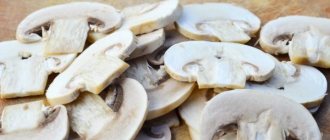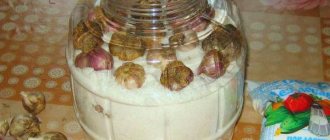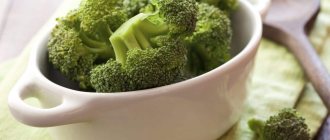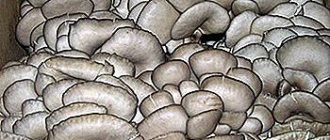How to choose the right broccoli?
Whether you buy fresh or frozen broccoli, you should always pay attention to its florets.
Broccoli florets should be green and tightly closed. Yellowed and slightly open inflorescences indicate that the cabbage is overripe and should not be consumed.
When frozen, broccoli florets should be unfrozen and also bright green in color.
Fresh broccoli should be stored in the refrigerator for no more than 3 days. If you store fresh cut broccoli for a week, then 50% of its beneficial properties disappear.
It is best to store separated broccoli florets in a vacuum-sealed container. In this form they can be stored for even a week.
Another option: after washing and drying the broccoli, cut it into florets, place it in a bag and put it in the freezer.
In addition, the inflorescences should be laid out in one layer so that they retain their shape and do not turn into a continuous mess. Thus, frozen broccoli can be stored for up to 6 months.
How to defrost broccoli? To defrost broccoli, place it in the refrigerator.
When buying broccoli, immediately pay attention to its freshness. The vegetable should be dense, hard, dark green in color, sometimes with a purple tint. The main thing is that the buds are closed; “shaggyness” and yellowness are signs that the fruit is overripe. The head of cabbage should be free of dark spots (this is rot), mold, etc., and the smell should be fresh and pleasant.
You can store cabbage in the refrigerator for about a week, after which it will lose its freshness. But if you take it apart into inflorescences and freeze it, then in this form the broccoli can last even the whole winter.
Do you need to wash cabbage?
Housewives often ask: do they need to wash cabbage? Definitely yes. But not after harvesting the garden or shopping at the store, but before preparing dishes.
- Prepare a large bowl, fill with water, add 3-4 tsp. vinegar.
- Dip the inflorescences into the solution for 12-15 minutes to remove debris and insects.
- Remove the vegetables, rinse, and blot to remove moisture.
- Use immediately for cooking.
Broccoli heads should go into the refrigerator half an hour after they were brought from the store or picked from the garden. Do not waste time, otherwise the vegetables will lose their nutritional value and freshness.
Composition, BJU and calorie content of broccoli (boiled, raw)
Scientists were able to study in detail the beneficial properties and contraindications of broccoli. The nutritional value is represented by the inflorescence (head). It is cut off in an underdeveloped form. If you miss the moment, the buds will turn into flowers. Such a vegetable will become unsuitable for eating.
The vegetable contains essential acids such as arginine, lysine, threonine, tryptophan, phenylalanine and others. Its pulp is rich in vitamins A, C, gr. B, E, K, PP. Of the minerals, the largest quantities contain magnesium, potassium, calcium, phosphorus, and sodium. The inflorescences are rich in iron, copper, manganese, zinc, and selenium.
The energy value depends on the growing conditions of the crop, region and variety. It is in the range of 30–34 kcal/100 g of raw product. The percentage ratio of broccoli BJU is 11:3:20.
The composition of this vegetable is, without exaggeration, unique. It contains proteins, fats, carbohydrates, fiber, minerals (zinc, iron, calcium, potassium, magnesium and others), vitamins U, PP, K, E. In terms of selenium and vitamin C content, broccoli has become a leader among vegetables. And in terms of the amount of vitamin U it is second only to asparagus. By the way, this component has the ability to heal and prevent the appearance of ulcers.
What else is so attractive about broccoli? Here is a list of “advantages” that make it a leader in healthy and tasty products:
- Low in calories, helps fight excess weight and burn fat. 100 grams of broccoli contain only 30 kcal.
- Stabilizes the functioning of the heart and nervous system, therefore it is indicated for people suffering from problems of the cardiovascular and nervous system.
- Chlorophyll, which provides the green color of plant leaves, also has a beneficial effect on blood formation and its composition.
- Contains substances that destroy atherosclerotic plaques on the walls of blood vessels, strengthen the vessels themselves and protect them from damage. For those who love sweets and also suffer from diabetes, broccoli is a must-have food.
- The large amount of fiber contained in cabbage helps cleanse the body of toxins, cholesterol, improve digestion and peristalsis.
- Amino acids have a rejuvenating effect, help fight the aging process, improve the condition and color of the skin. The happiness hormone serotonin, which is found in abundance in broccoli, increases tone and improves mood.
- A unique property of asparagus cabbage is its effect on cancer cells. It prevents their appearance and development in the body.
- Cabbage contains folic acid, which is often prescribed to expectant mothers, so for those planning a pregnancy, as well as for women in an interesting situation, broccoli must be present in the diet.
This miracle vegetable has practically no contraindications for consumption, except for individual intolerance. But people with pancreatic diseases and high acidity should be careful when including raw broccoli in their diet. And it is better not to eat cabbage broth, as it contains a high content of adenine and guanine.
Thanks to its simple preparation, excellent taste, rich composition and ability to rejuvenate the body, broccoli is used with pleasure not only by chefs and nutritionists, but also by cosmetologists. After all, on its basis you can prepare effective, pleasant and healthy masks for the skin of your hands, feet, face, body and hair.
With the help of this vegetable it is not difficult to get rid of early and shallow wrinkles. The whole secret is in the collagen fibers that broccoli is rich in. If you make masks from it 2 times a week for 10 weeks, your skin becomes 5-7 years younger.
Hair masks with broccoli perfectly smooth your hair, make it well-groomed, beautiful, manageable, and prevent the appearance of split ends, fragility, delamination, dandruff and dry scalp.
We suggest you read: How to make sauce without tomato paste
A unique oil is obtained from the seeds of broccoli cabbage, which can be used both in cooking and in cosmetology. It has a pleasant taste and aroma, has miraculous properties, and has a beneficial effect on the skin and hair, both from the inside and outside.
Scientists were able to study in detail the beneficial properties and contraindications of broccoli. The nutritional value is represented by the inflorescence (head). It is cut off in an underdeveloped form. If you miss the moment, the buds will turn into flowers. Such a vegetable will become unsuitable for eating.
How to cook broccoli tasty and healthy
The vegetable crop is used in cooking and as a preventive remedy that is good for health; The benefits and harms of broccoli are related to its composition. The vegetable has minimal contraindications.
So far, only individual intolerance to the components has been discovered. The beneficial effects of the product have been well studied:
- anti-inflammatory;
- antioxidant;
- anti-oncological;
- mild laxative;
- antisclerotic;
- hepatoprotective;
- anti-carcinogenic;
- adsorbent.
- Improves digestion - dietary fiber has a positive effect on intestinal motility.
- Reduces pain and eliminates nausea in case of duodenal ulcer and gastritis.
- Increases appetite, eliminating dyspeptic symptoms in liver diseases.
- Helps prevent atherosclerosis - it sorbs cholesterol in the intestines and prevents it from being absorbed into the blood.
- Useful in the dietary nutrition of patients with cholelithiasis and gout - the product contains very few purine bases (4 times less than cauliflower).
- Fresh juice has an antibacterial effect on mycobacterium tuberculosis and Staphylococcus aureus.
- Acts as an enterosorbent when the body is damaged by salts of heavy metals, poisons, and radionuclides.
There will be no particular harm from yellowed asparagus cabbage. If there is no rot on the inflorescences, they can be boiled and fried in batter. However, you should not expect any benefit from the product.
Vitamins are destroyed during storage. The older the cabbage, the less glucosinolates (nutrients with anti-carcinogenic properties) it contains. And the taste of the dish will be worse.
The vegetable has increased biological activity. The benefits of broccoli for women include a beneficial effect on the nervous system. The product helps to improve intestinal motor function and gastrointestinal function, and normalizes metabolism.
Nutritionists recommend using broccoli for weight loss. The inflorescences contain tartronic acid, which can prevent the transformation of carbohydrates into fat and cholesterol in case of excess body weight and the first degrees of obesity.
For personal hygiene and cosmetic procedures, take broccoli seed oil. It softens the lips and skin of the hands. Can be used as an additive for masks, conditioners, and hair shampoos.
The product contains enough calcium and phosphorus to strengthen bone tissue, which is especially important for women during menopause. Doctors also recommend it to support immunity.
- Regulates salt metabolism in the body, helping to remove excess fluid, which is especially important in the second half of pregnancy.
- The inflorescences contain folic acid, which is beneficial for fetal development.
- Helps relieve constipation in pregnant women.
- Positively affects the immune system and protects the body from infections.
It is highly undesirable for pregnant women to consume raw broccoli. It can increase gas formation in the intestines. The inflorescences are steamed and served with vegetable oil. The decoction is not used for food. Purine compounds, which are dangerous for pregnant women, pass into the liquid.
This is a useful product for nursing mothers. It is introduced into the diet a month after the birth of the baby. Broccoli is the safest type of cabbage for mother and newborn.
Regular consumption of asparagus cabbage (preferably steamed) will help the body resist the growth of cancer cells. It has been scientifically proven that cabbage contains substances that affect cancer. These are indole-3-carbinol, diindolylmethane, and a precursor to sulforaphane.
However, you can get a daily dose of indole-3-carbinol by eating 5 kg of raw cabbage heads per day. This is unrealistic. Therefore, the substance is consumed in the form of extracts. The daily dose of sulforaphane is contained in 250 g of raw product. Broccoli seed sprouts contain 50 times more of this substance.
There are about 200 varieties of broccoli. Their inflorescences range in color from almost yellow to green and purple. Recipes for cooking broccoli do not depend on the type of plant. They contain culinary techniques such as frying, baking, boiling. Salads, soups, casseroles and side dishes are prepared from the inflorescences. All types of cheeses, cottage cheese, rice, mushrooms, tomatoes, and basil go well with the product.
Preparation:
- Fry the diced onion in a saucepan.
- Add the chopped peppers to the saucepan and continue frying.
- Separate the tomatoes from the skin and chop (you can use a grater).
- Add the tomato mixture to the saucepan and bring to a boil.
- Cut the chicken fillet into cubes or large cubes and add to the vegetables.
- Place broccoli in a saucepan and mix ingredients.
- Cover the saucepan with a lid and simmer on low heat for 20 minutes.
- When serving, sprinkle with chopped herbs and you can add cream.
We suggest you read: Making a wicker fence at the dacha with your own hands
You can prepare 2 servings from the products offered. Cooking time: about 40 minutes. Ingredients:
- broccoli – 250 g;
- cream 35% – 100 ml;
- onions – 1 pc.;
- garlic – 1 clove;
- vegetable broth – 0.5 l;
- potatoes – 1 pc.;
- salt, pepper, nutmeg;
- white bread croutons.
Preparation:
- Chop the potatoes, chop the onion and garlic.
- Separate broccoli into florets.
- Pour the vegetables into a saucepan with hot broth and cook for 10 minutes.
- Grind the ingredients with a blender.
- Add cream and simmer for another 20 minutes.
- Throw in pepper, salt, nutmeg and boil.
- Serve with croutons.
Broccoli is recognized all over the world as a fighter against cancer. It also promotes active weight loss. Broccoli is a real storehouse of nutrients.
This article will discuss exactly why broccoli is useful, as well as how to choose, store and cook it correctly...
Broccoli is a real treasure trove of minerals and vitamins. It is a valuable source of calcium, magnesium, phosphorus, iron, copper, sodium, potassium, zinc, selenium, iodine; vitamins C, A, E, K, U, B2, B6, folic acid, omega-3 and omega-6, organic acids.
Broccoli is also rich in fiber and dietary fiber, which, together with its low calorie content (34 kcal/100 g), makes it a valuable product for weight loss.
Broccoli gained its fame due to its high content of glucosinolates - particularly important substances that have anti-carcinogenic properties and fight cancer.
Some of these substances are sulforaphane and diindolylmethane. They bravely fight cancer cells and kill them.
Lutein and zeaxanthin contained in broccoli improve vision and prevent the development of cataracts.
Broccoli makes bones and joints strong thanks to its high content of calcium, magnesium and phosphorus, which are involved in the formation of bone tissue.
This is why broccoli is good for children, adults, and the elderly (it prevents the development of osteoporosis).
Thanks to fiber and coarse dietary fiber, it removes waste, toxins, heavy metal salts, excess sugar, cholesterol from the body, cleansing the blood and blood vessels.
And vitamin C makes blood vessels strong and elastic. Thus, broccoli protects against atherosclerosis and cardiovascular diseases; improves blood circulation and normalizes blood pressure.
Due to its low calorie content (34 kcal per 100 g), as well as the presence of fiber, broccoli normalizes and increases metabolism, promoting weight loss.
Normalizes water-salt balance (due to potassium and sodium content).
Protects against the development of diseases of the gastrointestinal tract (including intestinal and prostate cancer).
Strengthens the immune system, increases resistance to various viral and infectious diseases. It is also a powerful antioxidant that kills free radicals.
Broccoli is a natural source of youth and beauty. It has a beneficial effect on the condition of the skin, hair and nails).
Reason #10
Longevity product (slows down the overall process of cell aging).
Reason #11
Helps with depression, insomnia and other neuropsychiatric diseases (with the help of B vitamins).
Reason #12
Improves the functioning of the thyroid gland.
Raw broccoli is the healthiest because it retains all the beneficial substances. In this form, broccoli can be added to salads, for example, broccoli salad with egg and tomatoes.
Broccoli, steamed, baked in the oven, boiled or stewed using ginger, garlic or other spices, can also become a favorite guest on your table.
At the same time, up to 80% of nutrients are retained in cabbage. In addition, broccoli goes well with poultry, meat and fish. For example, a casserole with broccoli and chicken in the oven turns out to be very tasty, light and healthy!
How to properly boil broccoli? When cooking, you should not bring cabbage to a mushy state, otherwise it will lose not only its taste, but also all its beneficial properties.
Simply place the broccoli florets in boiling, lightly salted water and blanch (cook) the broccoli for 2 to 3 minutes (maximum 5 minutes, but no more).
Next, remove the cabbage and immediately place it in cold water. This way the florets will remain intact, green and crispy. And one more tip: when adding broccoli to soup, add it at the very end.
- allergy to this product or individual intolerance;
- severe diseases of the gastrointestinal tract (ulcers, gastritis, pancreatitis, etc.)
So, today you learned the benefits of broccoli, as well as how to select, store and cook it. I hope that the 12 reasons described above will be the reason for such a valuable and healthy product as broccoli to become an invited and honored guest on your table!
Broccoli is the result of selection by the ancient Romans. It was cultivated back in the 6th-5th centuries BC. e. Outside the northeastern Mediterranean, little was known about the culture.
We suggest you read: Is it possible to eat boiled beets at night?
Only in the 17th century did the unusual cabbage come to England, where it was called “Italian asparagus”. And at the beginning of the 20th century, the crop began to be grown on an industrial scale in both hemispheres.
How long to cook broccoli (fresh, frozen)
Before cooking, cabbage inflorescences need to be prepared. Primary processing consists of several stages:
- the lower part of the stem is cut off along with the leaves;
- remove damaged inflorescences;
- disassemble the heads into separate inflorescences;
- if there are snails in the cabbage, soak it in salted or acidified water for 20 minutes.
To prepare boiled cabbage, the inflorescences are placed in boiling salted water with the addition of vinegar (1 tablespoon each of salt and vinegar per 3 liters of water). If frozen vegetables are used, they are also placed in boiling water. You can steam cabbage. For this, the inflorescences are placed in a colander over boiling water.
It is important not to overcook the product. Otherwise, it will become tasteless and of little use. Fresh cabbage is boiled for about 5 minutes after boiling. Frozen vegetables will take 10-12 minutes. To maintain a beautiful green color, boiled broccoli is immersed in ice water for a minute.
It's time to harvest
Let's first decide on the varietal assortment.
Of the 37 varieties in the register of breeding achievements, there is not a single one that breeders would recommend for fresh winter storage - only for home cooking. According to the growing season, all varieties are divided into:
- early ripening varieties ripen in 75-90 days;
- mid-ripening and late species mature at 105 days or more.
https://www.youtube.com/watch?v=https:PB5MF_jIFZY
To extend the consumption period, it is better to sow cabbage of different ripening periods, and also select those varieties that produce lateral heads. For example, the hybrid "Linda" after cutting the main head produces 7 side heads of 50-70 g each, but "Monterello" produces only one main head weighing 700 g.
So, it's time to harvest. The following tips will help keep broccoli fresh for a while:
- choose dense heads with a diameter of 13-18 cm;
- we select dark green ones, and with yellow spots, overripe ones - to the side;
- cut the heads of cabbage 10-12 cm below the base of the head;
- we leave the stems in the garden to collect a second harvest of young inflorescences (for certain varieties).
Harvest on a cool day, when the air temperature is not lower than -2 °C. Frozen cabbage will not last long, and the taste will deteriorate. High temperatures also harm the vegetable, causing it to wither and dry out.
If the broccoli has turned yellow, you can eat it.
Green broccoli with unopened flowers is healthy and rich in vitamins and minerals. Broccoli can turn yellow in two cases:
- the flowers on it blossomed and turned yellow
- During storage, the green (unblown) flowers withered and acquired a yellowish tint.
The result in both cases is the same - loss of taste and almost all nutritional qualities.
And now the answer to the question posed: is it possible to eat such cabbage? Yes, of course you can. But why? There is practically nothing useful left in it.
Broccoli, like any greens, should be eaten fresh, preferably just picked. Wilted greens can, perhaps, slightly revive the taste of the dish, but that’s all.
I bought fresh broccoli for my child. It lay there for 2 days and turned yellow on top, as if it had bloomed. What happened to her? And can I eat it or should I throw it away?
In general, in the summer I worked hard on preparing my son for the winter. But the freezer is not rubber, I understand that, I filled it completely, I even remembered that there was also a refrigerator in the village and I filled its freezer very quickly.
Beautiful girls, I came to you for advice and a request. Please share with us your menu for the day. We are now 1 year 1 month old (almost 2 already). Here's what we eat: Breakfast: Porridge 200 g (rice, buckwheat, oatmeal, corn) Fruit 50 g (plum, pear, pumpkin, banana) Lunch: Vegetable soup 200 g (broccoli, c.
Girls, what do you think, we’ve been eating carrots and pumpkin for a long time now, everyone began to notice that Aliska had turned a little yellow, the doctor also noticed, but didn’t forbid her to eat anything. Is it possible to continue eating yellow foods or is it not worth it? Besides pumpkin and carrots, Aliska only recognizes broccoli and cauliflower (which gives us constipation), and they stink terribly. But she doesn’t want to eat anything else, I tried. Options.
Problems since birth, I started breastfeeding only on the 4th day and then supplemented with expressed milk. She lived from feeding to feeding (weigh, breastfeed, weigh again, express what she didn’t eat and supplement). And so all the time. I left the maternity hospital on the 10th day with scales and a lamp (because they had turned yellow). I gained the initial weight only by the 15th day.
This is the story of motherhood in the age of high medical technology. This is the story of motherhood in an age of tyranny, negligence and impunity. This is the story of my motherhood. Motherhood of the 21st century. When I met my future husband, we were 20 years old. We began to live together almost immediately and build a future together.
Somehow I didn’t have time to tell you about our last month yesterday. The biggest disappointment is that we haven’t gained any weight at all (we weighed ourselves at home yesterday, just like we weighed 6,600 3 weeks ago), although we have grown (you can see from our clothes). But for the last week we’ve been sick and haven’t eaten almost anything, so we’ll be catching up on lost grams :)) Otherwise, everything was great!
Before leaving for Spain, I compiled “Instructions for Maxim” for the grandmothers. This was in the second half of March. If I think of it, I’ll also cook up something similar for the nanny. I'll just post it here as a keepsake. Maybe someone else will like this idea too.
Tags: broccoli, eat, can, turn yellow
About the author: admin4ik
« Previous entry
Storage in the basement, cellar
Some of the best conditions for storing broccoli are created in cool basements and cellars. If the room is ventilated, the temperature is maintained at 0 °C and the humidity is 90-95%, fresh cabbage will be on your table for 1-2 weeks.
Here's how to properly store broccoli in the basement and cellar:
- wrap each of the cut heads in newspaper or paper;
- store in baskets, drawers, placing them at some distance from each other;
- If the paper becomes damp, change it.
Cabbage turns yellow in two cases:
- at elevated temperatures its flowering begins;
- at low humidity it simply dries out.
Observe the humidity and temperature conditions, and everything will be fine with your supplies. There is no point in eating a yellowed vegetable - it no longer contains any taste or nutrients.











